The Chattahoochee River, originating in the Blue Ridge Mountains of north-central Georgia, is a breathtaking natural wonder meandering through the states of Georgia, Alabama, and Florida. This river’s geological history, shaped over millions of years, has sculpted humanity in this region as well as diverse landscapes. From start to end, this article will uncover how long the Chattahoochee River is, along with its ecology, geology, history, and more.
The Chattahoochee River’s ecology thrives in habitats ranging from lush forests to wetlands and mountains to plains. Its waters support various fish species, while its banks provide homes for a variety of mammals, birds, reptiles, insects, and amphibians.
Beyond its natural beauty, the river offers diverse activities. Hiking, cycling, boating, birdwatching, and lounging are popular along its banks, allowing people to connect with the natural world. For the adventurous, whitewater rafting is also a popular activity along certain sections of the river.
The Chattahoochee River is a cherished natural body of water in the southeastern United States. Its geological history, ecological richness, and recreational opportunities make it an invaluable resource, inviting all to explore, appreciate, and protect it.
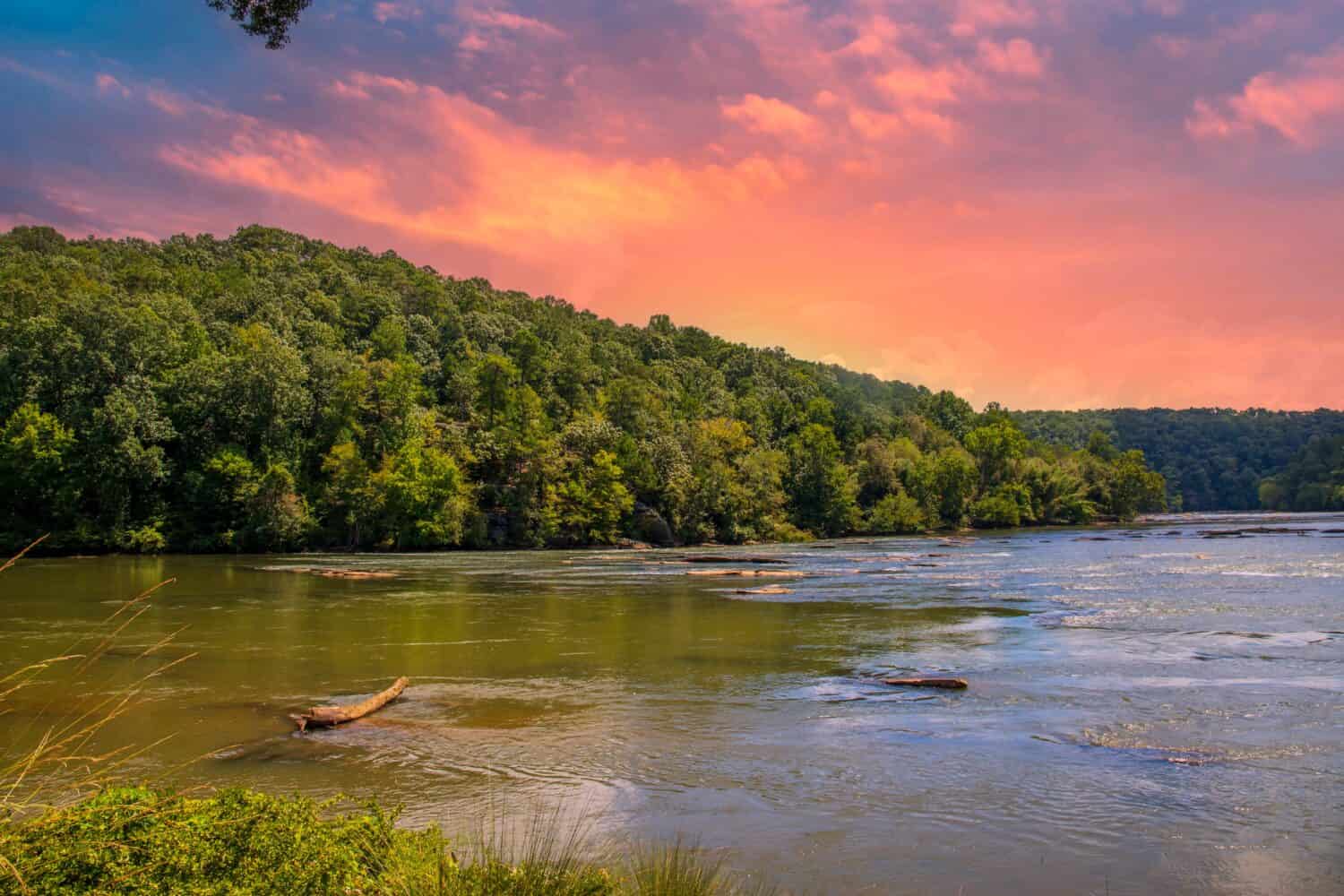
The Chattahoochee River begins in the southern Blue Ridge Mountains.
©Marcus E Jones/Shutterstock.com
How Long Is the Chattahoochee River?
The Chattahoochee River spans parts of Alabama, Georgia, and Florida in the southeastern United States. Moreover, the Chattahoochee River is an impressive 434 miles (698.5 kilometers) long from its source to its mouth, or from start to end.
Its source begins in Jacks Gap on Jacks Knob Mountain in the southern Blue Ridge Mountains in north-central Georgia. At its mouth, it combines with the Flint River into Lake Seminole on the border of Georgia and Florida within the city of Chattahoochee, FL. This marks the end of the Chattahoochee River and Flint River and the start of the Apalachicola River. From here, the Apalachicola River flows 160 miles (257.5 kilometers) to the city of Apalachicola, FL, where it empties into the Apalachicola Bay in the Gulf of Mexico. Together, the Chattahoochee River, Flint River, and Apalachicola River make up the Apalachicola–Chattahoochee–Flint River Basin (ACF River Basin). The Chattahoochee River itself comprises the largest section of the ACF’s drainage basin.
The Chattahoochee’s length plays a pivotal role in shaping the landscapes it traverses and the human populations residing nearby or along it. Furthermore, beyond its role in providing drinking water and recreational opportunities, the river’s length and composition contribute to the health of wetlands and floodplains along its course, creating vital ecosystems that sustain a plethora of flora and fauna.
Overall, this extensive river is known for its length as well as its ecological, geological, and historical importance, which this article will explore in depth in the following section.
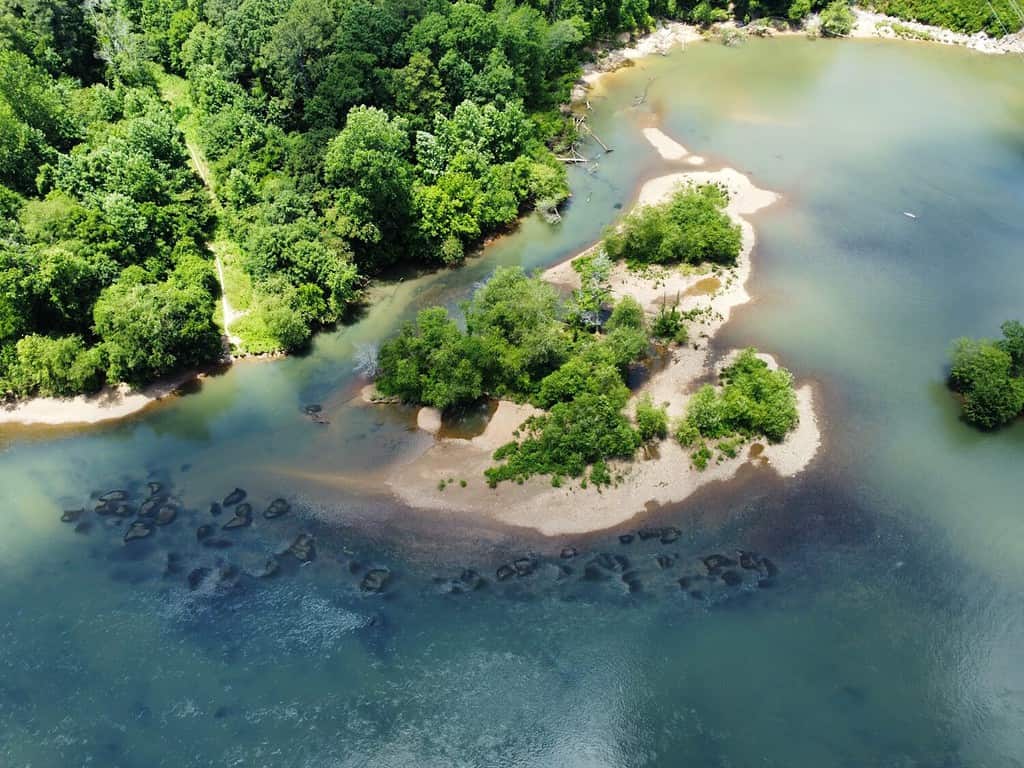
The Chattahoochee River is 434 miles (698.5 kilometers) long.
©Vivid Studio/Shutterstock.com
Location of the Chattahoochee River
The Chattahoochee River weaves through multiple states in the southeastern United States, leaving its mark and influence on the landscape.
Georgia
The Chattahoochee River originates in the southern Blue Ridge Mountains of north-central Georgia, specifically within the Chattahoochee National Forest. Its journey commences as water sources flowing south from the ridges that form the Tennessee Valley Divide converge, forming the headwaters of this iconic river. From here, it flows southward, passing through various cities and forming the picturesque Lake Lanier through the influence of the Buford Dam. This lake, fed by the Chattahoochee River, serves as a significant reservoir and provides the primary water supply for the Atlanta metropolitan area.
Alabama
As it continues its meandering course, the Chattahoochee River crosses the state line into Alabama, where it flows through various cities, towns, reservoirs, and artificial lakes. It blends through urban and rural landscapes and serves as a resource for both people and wildlife. Moreover, it rides the southern border of Alabama and Georgia.
Florida
The river’s journey ends in the Sunshine State, Florida, specifically in the city of Chattahoochee in the Florida Panhandle. Before reaching its destination, it widens considerably, forming the beautiful Lake Seminole on the border between Georgia and Florida, where it forms the Apalachicola River. The Apalachicola River continues, where it flows into Apalachicola Bay in the Gulf of Mexico.
The Chattahoochee River’s passage through these states underscores its significance as a vital watercourse, impacting ecosystems, communities, and economies along the way. It exemplifies the intricate connections between the natural world and human civilization, emphasizing the need for conservation and sustainable management.

The Chattahoochee River ends in Lake Seminole on the border of Georgia and Florida within the city of Chattahoochee, FL.
©Sandra Burm/Shutterstock.com
History of the Chattahoochee River
The Chattahoochee River, with its winding course through the southeastern United States, has a significant and, at times, dark history. It has witnessed the passage of time, cultures, and civilizations.
Early Inhabitants
The history of the Chattahoochee River dates back well over 3,000 years, with indigenous peoples being the region’s earliest inhabitants. Native American tribes in this region included the Muscogee (residing to the east) and Cherokee (residing to the west). They thrived along the river’s banks in their respective territories, drawing resources from in and around its waters and forging a deep connection with the river.
European Settlement
With the arrival of European explorers and settlers in the 16th century, the Chattahoochee River gained prominence in the context of early American history.
The early 18th century witnessed the establishment of European settlement with the forced removal of indigenous people. Colonizers took over the land by erasing the indigenous claims to make way for their settlement through land lotteries, treaties, and forced removals. This process lasted from approximately 1820 through 1832.
Industrialization and Economic Growth
As the United States expanded, the Chattahoochee River played a significant role in supporting the economic growth of European settlement. During the 19th century, water-powered mills and factories sprang up along its banks, harnessing the river’s energy for textile production and other industries. This industrialization transformed the region, spurring urban development and shaping the landscape.
Furthermore, the Chattahoochee River witnessed the tumultuous events of the American Civil War, with battles and skirmishes occurring along its course. Notably, the Chattahoochee influenced General William Tecumseh Sherman’s Atlanta Campaign, affecting military strategies.
In the post-war era, the river continued to be vital for transportation and trade. The development of railways and steamboats further enhanced connectivity in the region, allowing goods and people to move more efficiently.
Modern Conservation and Recreation
In the past century, the river has seen modifications and improvements. Moreover, in more recent decades, there has been a growing recognition of the importance of preserving the Chattahoochee River and its surrounding natural landscapes. Efforts in conservation and restoration have been undertaken to protect its ecosystems and promote recreational activities such as boating, fishing, and hiking.
Overall, the history of the Chattahoochee River is multifaceted and reflects the intertwined stories of nature and humanity. The river has played a central role in the region’s cultural, economic, and environmental history.
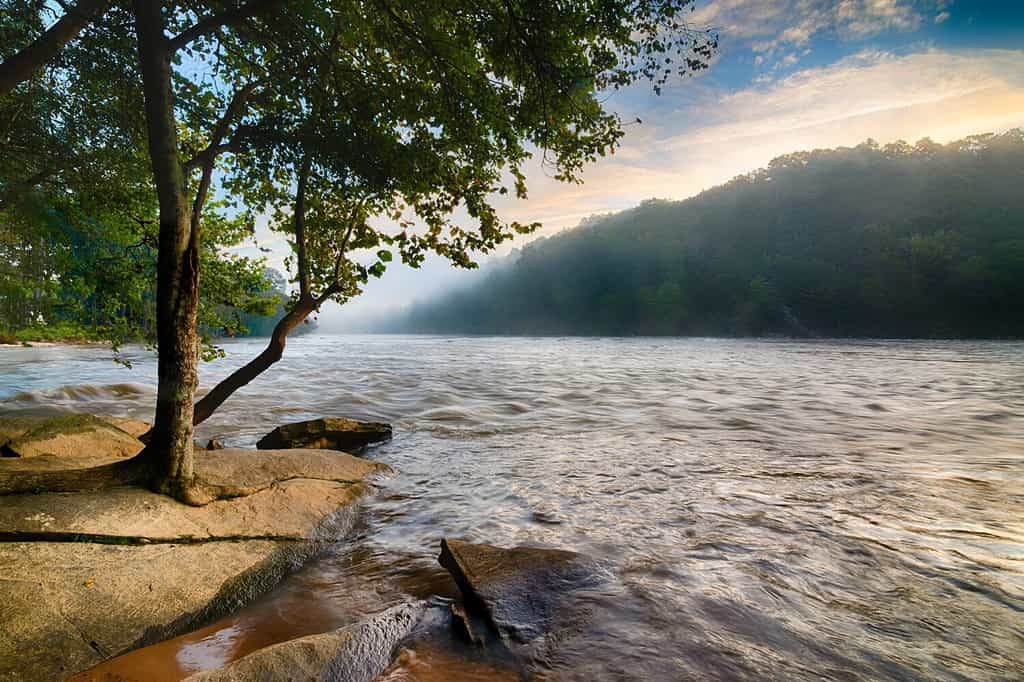
Various indigenous tribes lived on either side of the Chattahoochee River, the Muscogee, and the Cherokee before they were forcibly removed by European settlers.
©Rob Hainer/Shutterstock.com
Ecology of the Chattahoochee River
The Chattahoochee River is a remarkable geographical feature that is over 430 miles long and supports a thriving ecosystem with a diverse array of flora and fauna. This river’s ecology contains life that flourishes in and around its waters.
Flora
The Chattahoochee River is home to a wide variety of plant species. Each species adapted to its specific niche within the aquatic or riparian zones. These plant communities play a crucial role in stabilizing riverbanks, filtering water, and providing habitat and sustenance for both terrestrial and aquatic creatures.
Riparian Plants
The river’s banks are adorned with a mosaic of plant life, including hardwood trees such as oak, hickory, and maple trees. These trees offer shade and support a rich understory of shrubs and herbaceous plants. River birch is a common sight along the river’s edge, with its distinctive peeling bark. Moreover, other plants found along the banks include trout lilies, serviceberry, redbuds, azaleas, trillium, coreopsis, cardinal flowers, sumacs, and goldenrod, to name a handful.
Aquatic Plants
Within the river itself, various aquatic plants thrive. Submerged species like shoal lily and pickerel weed provide habitat and spawning grounds for fish and invertebrates. They adorn the shallower areas of the river, further offering shelter to waterfowl and amphibians.
Fauna
The Chattahoochee River’s waters also teem with animal life, from tiny invertebrates to apex predators. Its diverse habitats, including swift currents, quiet pools, and backwaters, create niches for a wide range of aquatic and terrestrial creatures.
Fish
The river is home to an impressive array of fish species. Native species like the shoal bass (Micropterus cataractae), gizzard shad (Dorosoma cepedianum), and Alabama shad (Alosa alabamae) find refuge in its flowing waters. The Chattahoochee also supports introduced species like rainbow trout (Oncorhynchus mykiss) and brown trout (Salmo trutta), making it a favored destination for anglers.
Mammals
The vegetation along the Chattahoochee River provides habitat for various mammals. White-tailed deer (Odocoileus virginianus) and gray squirrels (Sciurus carolinensis) are commonly seen. At the same time, American beavers (Castor canadensis) actively shape the riverbanks with their activities.
Birds
The river and its surrounding habitats attract a plethora of bird species. Ospreys (Pandion haliaetus) soar above, hunting for fish and forest critters, while great blue herons (Ardea herodias) wade through the shallows. Migratory songbirds, including warblers and orioles, stop along the Chattahoochee’s course during their annual journeys.
Reptiles and Amphibians
The river’s waters provide ideal breeding grounds for amphibians such as American bullfrogs (Lithobates catesbeianus) and southern leopard frogs (Lithobates sphenocephalus). Along the riverbanks, eastern painted turtles (Chrysemys picta) and various snake species, including the non-venomous eastern rat snake (Pantherophis alleghaniensis), find shelter and food.
Insects and Invertebrates
The river’s health is intimately connected with the abundance of insects and invertebrates. Mayflies, stoneflies, and caddisflies are indicators of good water quality. These aquatic insects, along with crustaceans like the Chattahoochee crayfish (Cambarus howardi), serve as a vital food source for fish and other aquatic species.
Conservation Efforts
While the Chattahoochee River’s ecology remains resilient, it faces various challenges, including habitat loss, pollution, and the impacts of climate change. Numerous conservation efforts are underway to safeguard its rich biodiversity. These include habitat restoration projects, water quality monitoring, and the establishment of protected areas along the river’s course.

White-tailed deer are a common sight along the Chattahoochee River.
©Tom Reichner/Shutterstock.com
Geology of the Chattahoochee River
The Chattahoochee River tells a geological story that spans over 100 million years. Its formation and the geological features it carries reveal the intricate processes that have shaped the region’s landscape.
Like many rivers, the Chattahoochee River owes its existence to a complex interplay of geological forces. The river’s course is primarily defined by the region’s underlying bedrock, sedimentary formations, and the erosive power of flowing water.
Appalachian Mountains
The Chattahoochee River takes its first steps amidst the rugged terrain of the Blue Ridge Mountains. These ancient mountains are predominantly composed of metamorphic rocks, including schist, gneisses, slates, and quartzites.
Sedimentary Deposits
As the river flows southward, it encounters sedimentary rock formations. It flows over the fall line. This is a transitional region between the foothills of the Piedmont as well as the lower Coastal Plain. A mix of igneous and sedimentary rocks characterizes it. Sedimentary rocks, like sandstone and limestone, bear witness to the ancient seas that once covered this area. Over eons, these sedimentary deposits have eroded, contributing to the river’s sediment load.
Erosion and River Dynamics
Erosion is a driving force in the Chattahoochee’s geological narrative. The river’s flow, influenced by gravity, carries sediment downstream. This continuous process of erosion, transportation, and deposition shapes the river’s channel and its surroundings. Over time, the Chattahoochee has carved out valleys, created meanders, and formed floodplains that support diverse ecosystems.
Valleys and Floodplains
One of the striking geological features along the Chattahoochee River is its floodplains. These expansive areas experience periodic flooding, which deposits nutrient-rich sediment. Over thousands of years, this process has created fertile farmland and wetland habitats.
Human Influence
It’s important to note that human activities have also influenced the geology of the Chattahoochee River. Dams, reservoirs, and urbanization have altered the river’s flow and sediment transport. For instance, the construction of Buford Dam created Lake Lanier, a reservoir on the Chattahoochee that regulates the river’s flow downstream. While these modifications serve various purposes, they also have consequences for the river’s geological processes.
Geological Significance
The Chattahoochee River’s geological history offers valuable insights into the dynamic nature of Earth’s landscapes. It underscores the ceaseless interaction between geological forces and the flow of water, resulting in the sculpting of valleys, the creation of fertile floodplains, and the formation of diverse habitats.
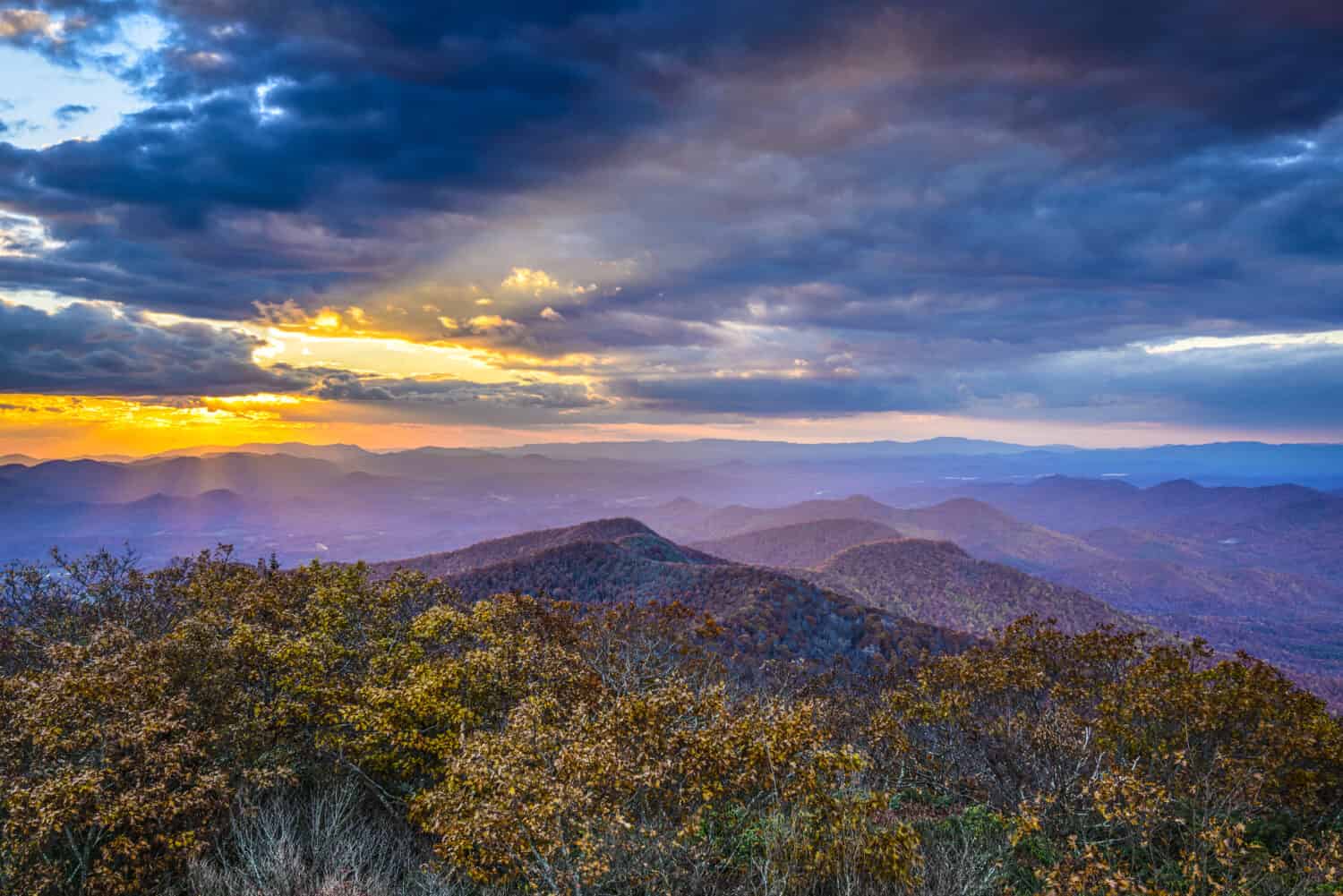
The southern Blue Ridge Mountains mark the beginning of the Chattahoochee River.
©Sean Pavone/Shutterstock.com
Activities and Destinations on the Chattahoochee River
The Chattahoochee River offers a wealth of activities and destinations for those seeking to connect with nature, engage in outdoor recreation, and explore the river itself. This meandering river presents diverse opportunities to immerse oneself in its beauty and vitality.
Activities on the Chattahoochee River
Boating and Canoeing
The Chattahoochee River invites boaters of all kinds to traverse its scenic waters. Whether you prefer a leisurely paddle or a thrilling ride through sections of rapids, various sections of the river are suitable for different skill levels. Kayaking, canoeing, and paddleboarding are also popular choices for those seeking non-motorized boating adventures.
Fishing
The river is a destination for anglers, offering opportunities to catch a variety of fish species, including bass, catfish, trout, and more. Fishing is a beloved pastime along the Chattahoochee River, and the river’s diverse ecosystems provide ample spots for both beginners and experienced fishermen in addition to a variety of fishing methods.
Hiking and Biking
Many trails wind alongside the Chattahoochee River, providing hikers and cyclists opportunities to explore the surrounding natural beauty. For example, the Chattahoochee River National Recreation Area has numerous trails that cater to different levels of hikers, from strolls to challenging hikes.
Picnicking and Relaxation
The riverbanks offer serene spots for picnicking and relaxation. Families and friends can gather for a picnic while taking in the soothing sights and sounds of the river. It’s a perfect way to connect with nature and unwind, perhaps by reading a book, doing yoga, or playing chess.
Wildlife Viewing
The Chattahoochee River is home to an abundance of wildlife and provides plenty of viewing opportunities. Birdwatchers can spot a variety of avian species, including herons, ospreys, and woodpeckers. Mammals like rabbits, chipmunks, deer, and foxes are also commonly observed along the river’s edge.
Destinations Along the Chattahoochee River
Chattahoochee River National Recreation Area
This extensive park system, managed by the National Park Service, encompasses multiple units along the Chattahoochee River, covering around 10,550 acres. It provides a wide range of recreational opportunities, including hiking, camping, and river access. Cochran Shoals and Island Ford are popular units within the park.
Morgan Falls Overlook Park
Located near Sandy Springs, GA, this park offers stunning views of the Chattahoochee River and the Morgan Falls Dam. It features walking trails, a fishing pier, and picnic areas.
Columbus RiverWalk
In Columbus, GA, the Chattahoochee RiverWalk is a scenic 4.4-mile urban trail that meanders along the river. It’s ideal for walking, cycling, jogging, or simply enjoying the riverfront ambiance.
Lake Lanier
This reservoir along the Chattahoochee River in Georgia offers plentiful water-based recreational activities. It covers an expansive surface area of approximately 37,000 acres with a maximum depth of 48 meters. Over 10 million people visit annually. The lake is top-rated for boaters of all kinds, houseboats, jet-skiing, rowing, swimming, and many other activities.
Whether you seek adventure, relaxation, or a deeper connection with nature, the river and its surrounding destinations have much to offer.
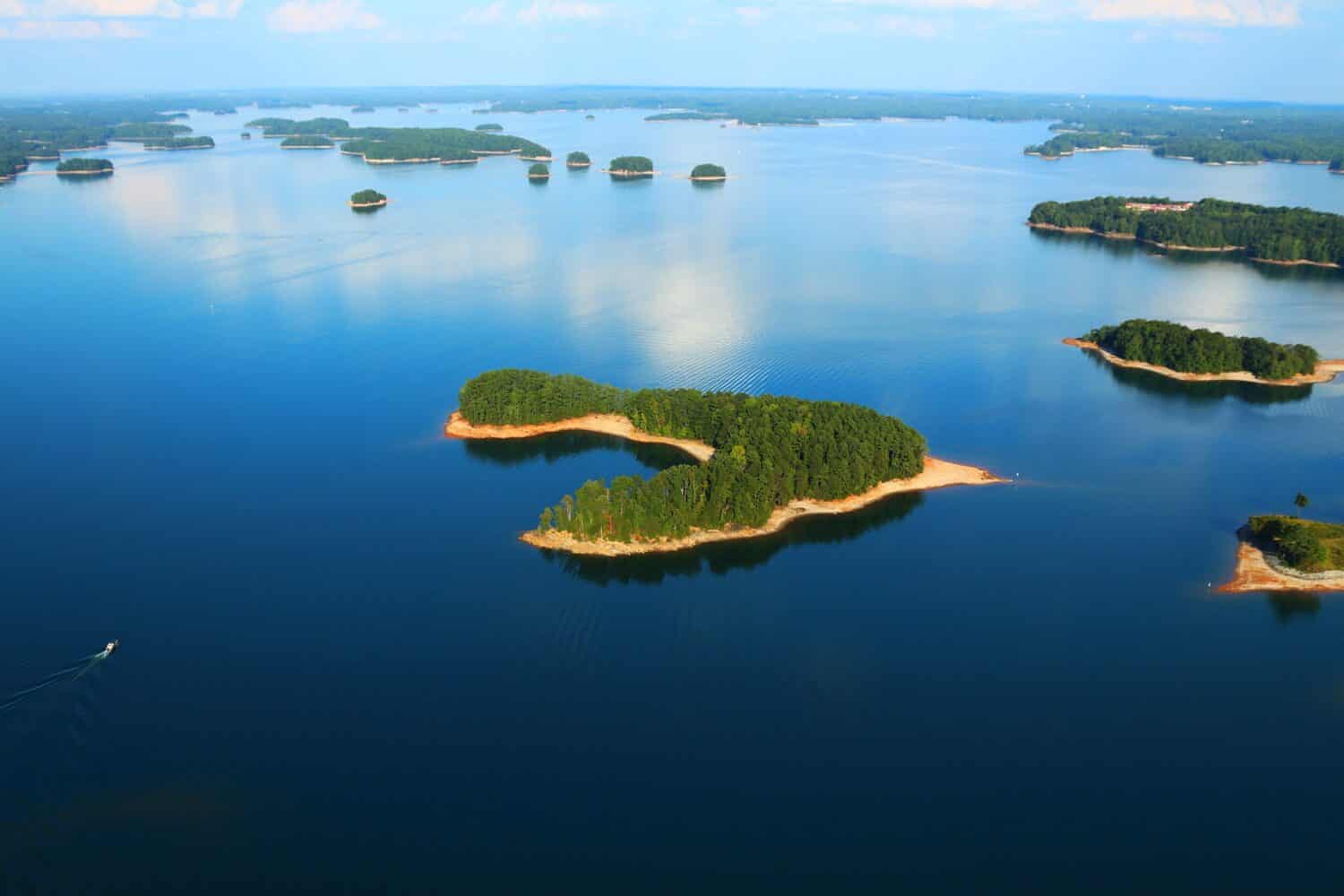
Lake Lanier is a popular man-made reservoir along the Chattahoochee River.
©Brett Barnhill/Shutterstock.com
Where is the Chattahoochee River Located on a Map?
The Chattahoochee River is situated in the southeastern United States, flowing through the states of Georgia, Alabama, and Florida. Starting in north-central Georgia in the southern Blue Ridge Mountains, it flows southwest to the border of Alabama and Georgia, where it then flows south to the border of Florida and Georgia, ending in Chattahoochee, FL.
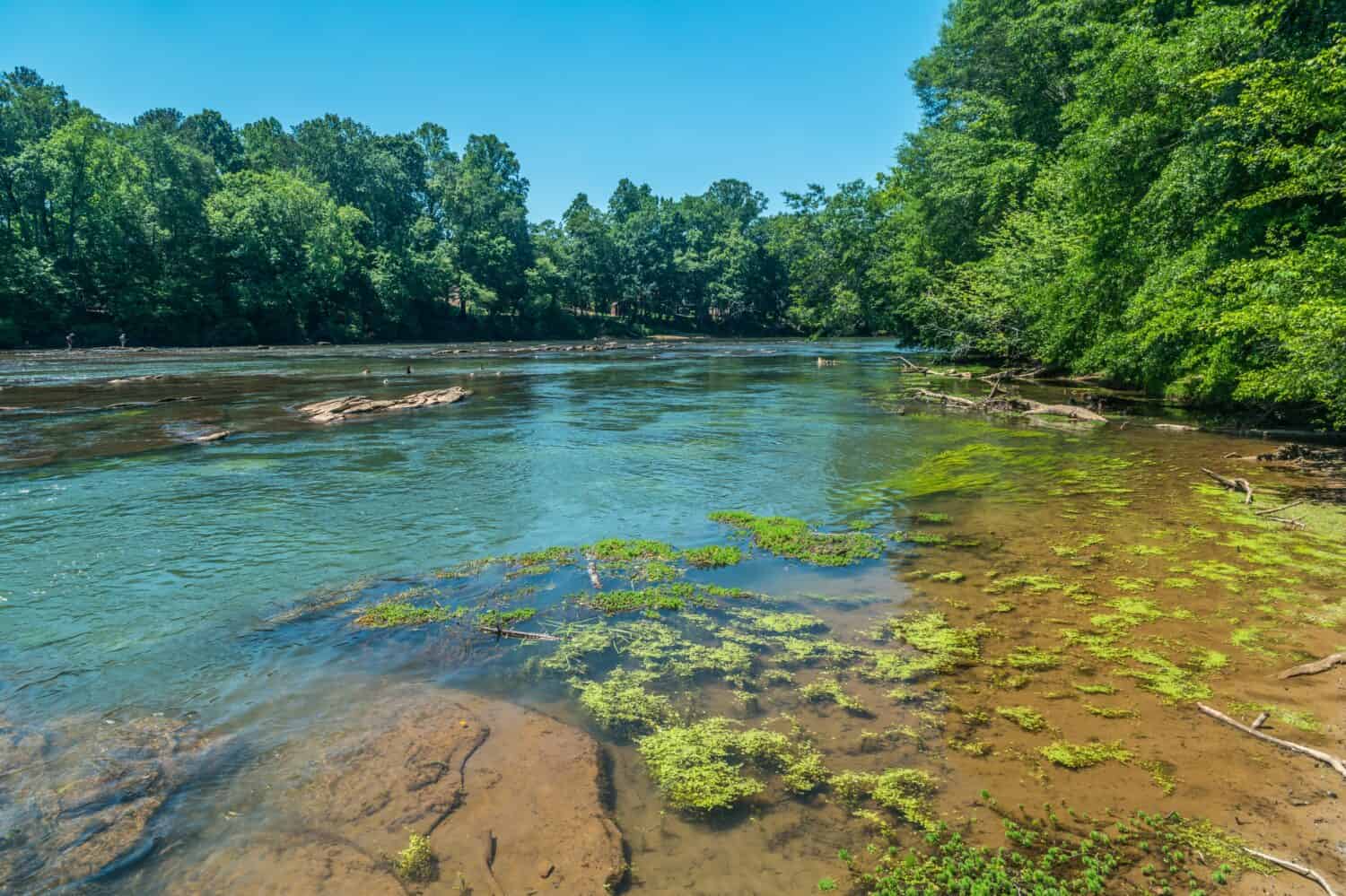
The Chattahoochee River provides plenty of opportunities to enjoy outdoor recreation.
©Sandra Burm/Shutterstock.com
Conclusion
In conclusion, the Chattahoochee River, spanning approximately 434 miles (698.5 kilometers) from its origin in the ancient Blue Ridge Mountains in north-central Georgia to Lake Seminole on the border of Georgia and Florida within the city of Chattahoochee, FL, emerges as a captivating resource in the southeastern United States. This winding course showcases a rich history of geology, ecology, and human civilization. Moreover, it supports a myriad of wildlife, from diverse fish species to mammals, birds, reptiles, and more.
Beyond its ecological significance, the Chattahoochee River is a source of inspiration and recreation. Activities such as hiking, biking, boating, camping, and thrilling whitewater rafting adventures invite those seeking outdoor experiences. This natural gem encapsulates the enduring beauty and complexity of the natural world, inviting all to explore, appreciate, and protect this invaluable resource.
The photo featured at the top of this post is © Vivid Studio/Shutterstock.com
Thank you for reading! Have some feedback for us? Contact the AZ Animals editorial team.







